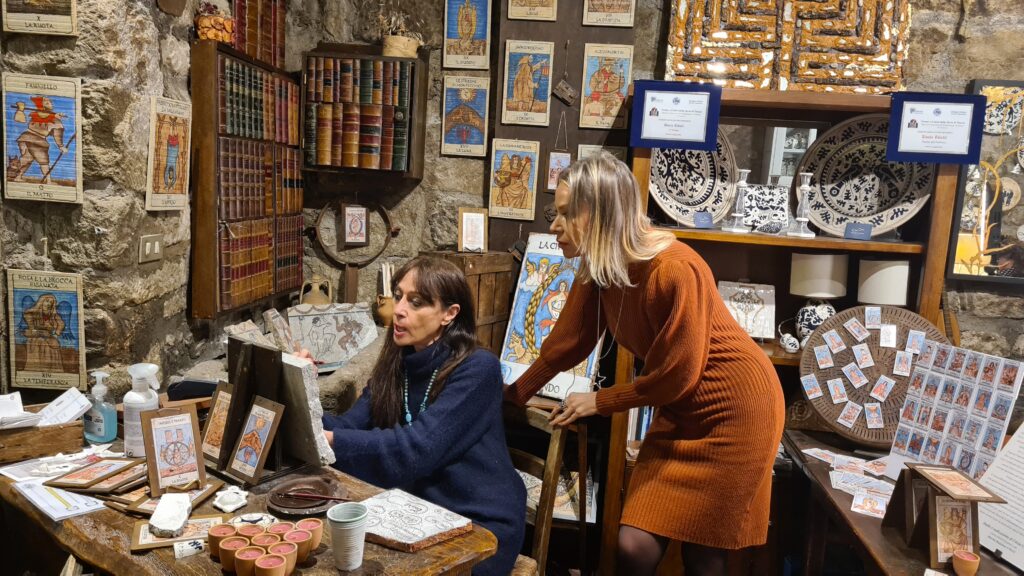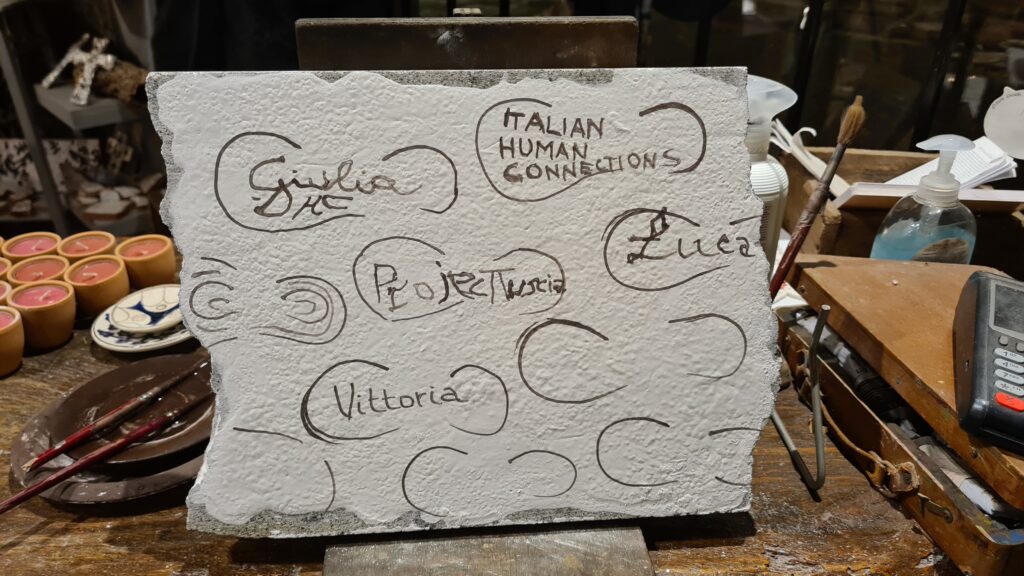Every town or small village can hide an undergrowth of human energies and connections ready to be intercepted and shared. Sometimes it is easy to wander down the streets and stumble upon a beautiful lab or handicraft shop, other times these places are more hidden, almost secret, and you need a local friend to be able to discover them. My desire is to hold your hand and take you to these creative worlds where energies and human connections find their higher expression. I want you to get to know artisans and artists, meeting their spirits in their labs and through their art. Magical encounters that can enrich you with emotions and human connections always new.

Cinzia Chiulli is an extraordinary artist, but also a friend, a philosopher, and a lovely enchantress who knows how to delight you with her tales about local historical characters, the world of Tarots, and the medieval esotericism of Viterbo. In this sense, her studio also becomes an intellectual salon where you can absorb positive energies and always new knowledge.
I decided to keep one of her ceramics depicting the life tree next to my bed, not just because it is wonderful, but because it is full of symbolism and inner significances.
It is the first image I see when I wake up in the morning and the last one before I fall asleep. It is there to remind me of the importance of my inner balance from which I can draw the seeds of life to be sown in the world to give birth to ever new human connections.
The Noble Art of Ceramics and Tarots in Viterbo
Entering Cinzia Chiulli’s studio we are overwhelmed by vibes, energy, and the spirit of this artist is imprinted in every single work of art created by her. After all, the work of art is a divine creation that embodies the soul of the artist herself in its matter..
But there is more. According to the law of quantum mechanics, even if we perceive a work of art as still, in reality, it is made up of 99.9999% of flowing energy and 0.0001% of matter. This free energy is able to produce phenomena when it is observed. That’s the reason why we feel invested by mystical and spiritual inner vibes when we lay our eyes on Cinzia’s beautiful masterpieces.
Her passion for the noble art of ceramics combined with her many years of research on medieval Viterbo techniques make her artistic production unique and refined.
The ancient workings require time, patience, and somehow slowness. In a world where everything spins fast, even art can be contaminated by rush, but the ancient traditions have the power to sweeten the creative moment, making it immersive and more profound.
So you won’t be surprised if Cinzia’s ceramics need calm and long dedication to be created. Metaphorically it can be thought that every single piece of pottery can contain in itself a little part of Cinzia’s life. Creation is for Cinzia like a long gestation that gives life to a new “creature” that somehow embodies a little piece of herself. She says that she never has the feeling to sell her creations, but that she is giving them up for adoption because as an artist she can’t really separate herself from that part of herself.
The Middle Age is also obscurity, mystery, occultism, and esotericism, and for Cinzia Chiulli is not enough just to study the ancient artistic traditions of artisan schools to create her ceramics. She also needs to reproduce through her art the icons, symbols, and arcana of the past, and this is how she approaches the world of Tarots.
Tarot cards have mysterious and ancient origins, and Viterbo is the first Italian town to welcome them. Scholars claim that they were brought by Templars around the 13th century. They are essentially a soul map, a deep psychological guide to self-empowerment as imagined through 78 symbolic cards.
A traditional deck has 22 Major Arcana which are the archetypal images. There are 56 Minor Arcana cards and four elements or suits: Fire, Earth, Air, and Water. These cards follow a narrative that tells about the spiritual evolution of humanity towards enlightenment to reach our higher self, which is the ultimate purpose of Tarot cards. The images are simple and tell without speaking, so much so that Tarots have been compared to the silent book “Mutus Liber“, a masterpiece of 17th century French alchemy.
Tarot cards are also an allegory of our lives, a sacred mirror in which each of us recognizes oneself. They represent what occultists call the conversation with our higher self. We are like the Magician (Arcanum number one), we must perform the magic of believing in ourselves to reach ever-higher spiritual goals.
Following these studies, Cinzia Chiulli has created the Major Arcana of FAUL, the acronym of four ancient places in Viterbo (Fano, Arbanum, Vetulonia, and Longula). Viterbo is itself an alchemical and esoteric town, you can see it in the symbols imprinted on the city walls, and in the churches.

The big challenge of this artist was to match the historical characters and events of Viterbo to the iconography and symbolism of Tarots without altering their original significance.
For instance, the card number one, The Magician, is represented by Pietro Hispano, the alchemist Pope John XXI, hated by the clergy because he was considered a kind of sorcerer and died in Viterbo due to an explosion during one of his strange experiments. Other important characters are Donna Olimpia Pamphili, sister-in-law of Pope Innocent X and Princess of San Martino al Cimino, the Emperor Frederick II, the Bella Galliana (a beautiful girl, icon of Viterbo History), Giulia Farnese, and so on. Cinzia’s Major Arcana tell about human beings of the past that connect with us through the magic of Tarots. A human connection that spans the centuries.
The Major Arcana of FAUL have become not just a simple deck of cards but also a monumental ceramic creation composed of 22 slabs of peperino (a local volcanic stone) upon which the images are gazed and painted with mineral oxides diluted with local sulfurous water so that the entire collection releases the spirit and the energy of this enchanting land.
Cinzia Chiulli also uses peperino for another wonderful project called “Your step is already history”. Her idea is to create in Viterbo a path paved with stones on which the pilgrim’s step is imprinted. Basically, each pilgrim can write his name or leave his footprint on a peperino brick that the artist will use to pave the Pilgrim’s Path.
Each pilgrim through his pilgrimage makes an interior journey and in this sense the path also assumes the metaphor of an encounter with oneself.
Cinzia’s world is truly vast but we could close this journey in her studio and her ceramics with an aphorism of hers which contains her whole concept of art: “Creation can be defined as art only when has the power to transfer energy and emotion”.
And entering Cinzia Chiulli’s studio is an overwhelm of vibrations, energy, and emotions.
Note:
Cinzia Chiulli is currently considered one of the greatest experts in ancient Italian ceramics. She has worked in many countries around the world.
Since 2001 she has been teaching ceramic painting, restoration, and fresco painting for the American school SYA (School Year Abroad), which has three bases in the world: Viterbo, Paris, and Beijing.
The original Major Arcana of FAUL are exhibited at the Colle del Duomo Museum in Viterbo.
















[…] Medieval Town of Viterbo 22 kilometers […]
Come to visit